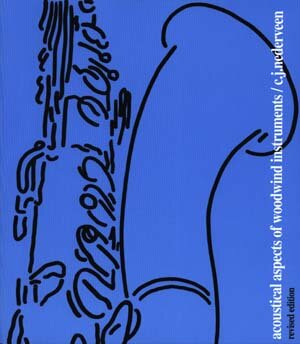
|
WW001: Acoustical Aspects of Woodwind Instruments, Revised Edition by C. J. Nederveen. Northern Illinois University Press, PB, 160 pages. A detailed mathematical study of the subject. Contents include: the excitation mechanism of woodwinds, holes and bore perturbations, examples, and an addendum of developments since 1969 first edition. (Published in July 1998.) |
29.95

|
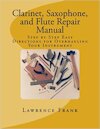
|
WW007: Clarinet, Saxophone, & Flute Repair Manual - Step by Step Easy Directions for Overhauling Your Instrument by Lawrence Frank, Frank Woodwind Repair, SB, 76 pages. This books was written because of the author's dissatisfaction with other repair manuals. It is intended for clarinet, saxophone, and flute players from high school through professionals who want to work on their own instruments. It is also recommended for band directors who need to do emergency repairs. This book is no longer available to us, but you can order it here from Amazon. |
|
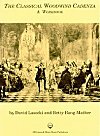
|

WW016: The Classical Woodwind Cadenza, A Workbook by David Lasocki & Betty Bang Mather. McGinnis & Marx, 1979, SS, 60 pages. This workbook is designed to involve the performer of eighteenth-century woodwind music in the composition of classical cadenzas. Included are examples of the few surviving cadenzas preserved in published and manuscript form. |
15.95

|
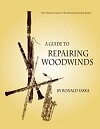
|
 WW002: A Guide to Repairing Woodwinds Second Edition by Ronald Saska. Roncorp, 2013, SB, 244 pages. This book was originally developed for the woodwind repair courses at the State University of New York, College at Morrisville. The book is intended for those who wish to learn professional repair techniques using professional equipment. The clarinet is the subject of the basic repair instruction. Additional information is provided for repairing oboes, flutes, bassoons, saxophones, and harmony clarinets. Nine appendices include useful reference information on repair procedures, tools, equipment and supplies. For the second edition this book has been typeset and the appendices that cover the suppliers of tools, parts, and supplies have been brought up to date. Click on the cover image to view the Table of Contents. WW002: A Guide to Repairing Woodwinds Second Edition by Ronald Saska. Roncorp, 2013, SB, 244 pages. This book was originally developed for the woodwind repair courses at the State University of New York, College at Morrisville. The book is intended for those who wish to learn professional repair techniques using professional equipment. The clarinet is the subject of the basic repair instruction. Additional information is provided for repairing oboes, flutes, bassoons, saxophones, and harmony clarinets. Nine appendices include useful reference information on repair procedures, tools, equipment and supplies. For the second edition this book has been typeset and the appendices that cover the suppliers of tools, parts, and supplies have been brought up to date. Click on the cover image to view the Table of Contents. |
42.95

|
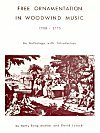
|

WW014: Free Ornamentation in Woodwind Music 1700-1775 by Betty Bang Mather & David Lasocki. McGinnis & Marx, 1976, SB, 158 pages. This book on free ornamentation is intended for woodwind performers. The authors have found written out examples of ornamentation in manuscripts of the period and presented them along with guidelines for various composers and schools of playing (Italian, French, etc.) |
21.95

|
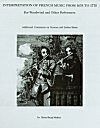
|

WW015: Interpretation of French Music from 1675 to 1775 by Betty Bang Mather. McGinnis & Marx, 1973, SS, 104 pages. Subtitled: For Woodwind and Other Performers, Additional Comments on German and Italian Music. This book focuses on the 50 years from 1700 to 1750 when woodwind (especially flute) music was popular and the performance practices for French music were distinctive. The three principal subjects are rhythmic inequality, articulation, and ornamentation. The book is packed with musical examples and includes appendices, bibliography, and index. .
|
19.95

|
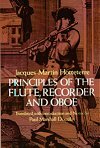
|
WW008: Principles of the Flute, Recorder and Oboe by Jacques-Martin Hotteterre translated, with introduction and notes by Paul Marshall Douglas. Dover, PB, 73 pages. The finest flutist of his time, Jacques-Martin Hotteterre (1680?-1760?) wrote this instruction book for the transverse flute, recorder and oboe. This work has considerable practical use today as well as its importance in the historical development of the flute. Most significantly it contains an extensive discussion of ornaments and embellishments of the period. Despite its importance it was not available in English prior the original publication of this translation in 1968. |
9.95

|
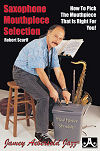
|
WW026: Saxophone Mouthpiece Selection by Robert Scarff. Jamey Aebersold Jazz, 2006, SB, 88 pages. This book contains information on mouthpiece parts and design, guidelines in selecting a mouthpiece for the type of sound you need, facing charts for commercial saxophone and clarinet mouthpieces, and chamber designations of some representative brands of saxophone mouthpieces. This book also includes guidance on reed adjustments, some maintenance tips, and some musician jokes. While this book is primarily oriented toward the saxophonist, clarinetists will also find useful information here. This is a new printing by a regular music publisher (it was previously self-published by the author) at a big reduction over the old $22.95 price.
|
9.95

|
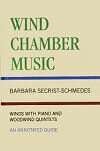
|
WW012: Wind Chamber Music - Winds with Piano and Woodwind Quintets - An Annotated Guide by Barbera Secrist-Schmedes. Scarecrow Press, 1996, HB, 186 pages. About one quarter of this book is a listing of works for two to five dissimilar woodwinds (including horn) and piano. The rest lists woodwind quintets. The listings include composer (with nationality and dates), title, instrumentation, date, duration, arranger (if any), publisher; and the catalog number of any known recording. Many entries have descriptions. This book is not currently available and may not be reprinted. If you are interested in it, send us a message and we will check on its status (2/8/13).
|
55.95

|
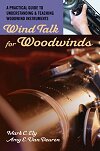
|
WW242: Wind Talk for Woodwinds by Mark C. Ely and Amy E. Van Deuren. Oxford University Press, 2009, PB, 751 pages. This book provides instrumental music teachers, practitioners, and students with a handy, easy-to-use pedagogical resource for woodwind instruments. With thorough coverage of the most common woodwind instruments - flute, oboe, clarinet, saxophone, and bassoon (100+ pages each) - the book offers the most topical and information necessary for effective teaching. This includes terminology, topics, and concepts associated with each specific instrument, along with teaching suggestions that can be applied in the classroom. It also includes a "Practical Tips" section, which discusses common technical faults and corrections, common problems with sound (as well as their causes and solutions to them), as well as fingering charts, literature lists (study materials, method books, and solos), as well as a list of additional resources. An impressive book which considering it is published by Oxford has a "modest" price.
|
58.95

|
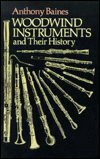
|
WW006: Woodwind Instruments and Their History by Anthony C. Baines. Dover, PB, 384 pages. By the author of Musical Instruments Through the Ages. The definitive book on woodwind history, fully illustrated. The book is divided into two parts, Part One, The Woodwind Today, includes a general introduction, the flute, piccolo, reeds and reed-making, the oboe, the clarinet, and the bassoon. Part Two, History, has chapters on The Primitive Flute World, Early Reed Instruments and Double-piping, Medieval Wind Music, The Sixteenth Century and the Consorts, The Eighteenth Century and the Classical Woodwind, and Mechanization. The book also includes three appendices, bibliography, glossary of terms, and an index. |
22.95

|
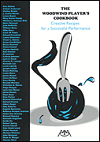
|
WW179: The Woodwind Player's Cookbook edited by Charles West. Meredith Music, 2008, PB, 178 pages. Subtitled Creative Recipes for a Successful Performance, this valuable collection of quick-to-read yet deeply insightful strategies is like finding expert trade secrets all placed in one convenient source. With outstanding records of performance, workshop clinics, recordings, research, composition, leadership and teaching, the 57 authors provide their favorite “recipes” that range from overviews of successful programs to specific topics that will inspire all levels and types of ensembles and performers. Sample “recipes” include: Developing Facility on the Bass Clarinet (J. Lawrie Bloom), Breathing Demystified (Leone Buyse), Recipe for Preventing Play-Related Health Problems (William J. Dawson, M.D.), How Should I Test a Saxophone Mouthpiece? (Eugene Rousseau), and many more. Click on the cover image to view Table of Contents. Use your browser's Back button to return. |
24.95

|

